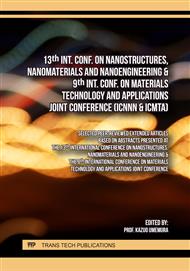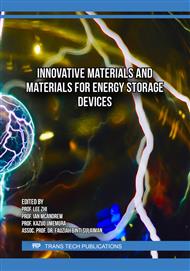[1]
T.A. Tawfik, M. Slaný, and M. T. Palou: Influence of heavyweight aggregate on the fresh, mechanical, durability, and microstructural properties of self-compacting concrete under elevated temperatures, J. Build. Eng., vol. 80, (2023).
DOI: 10.1016/j.jobe.2023.108104
Google Scholar
[2]
P. Pournoori, A. Davarpanah T.Q, A. Rajaee, M. Ghodratnama, S. Abrishami, and A. R. Masoodi: Experimental exploration of fracture behavior (pure mode III) in eco-friendly steel fiber-reinforced self-compacting concrete with waste tempered glass as coarse aggregates. Sci. Rep., vol. 14, no. 1, (2024).
DOI: 10.1038/s41598-024-58912-z
Google Scholar
[3]
R.B. Singh: Self-compacting concrete containing ground granulated blast furnace slag: A review. Indian Concrete Journal, vol. 94, no. 12, p.44–52, (2020).
DOI: 10.21275/v4i12.nov152002
Google Scholar
[4]
M.I. Al Biajawi, R. Embong, and A. Shubbar: Engineering properties of self-compacting concrete incorporating coal bottom ash (CBA) as sustainable materials for green concrete: a review. J. Build. Pathol. Rehabil., vol. 8, no. 2, (2023).
DOI: 10.1007/s41024-023-00352-9
Google Scholar
[5]
S. Vijaya Kumar, B. L. P. Swami, and B. Dean Kumar: Experimental Study on the Presence of Mineral Admixtures and Steel Fiber on the Elastic Properties of Self-Compacting Concrete (SCC), in IOP Conference Series: Materials Science and Engineering, (2020), vol. 983, no. 1.
DOI: 10.1088/1757-899x/983/1/012011
Google Scholar
[6]
B. S. Institution. and E. C. for Standardization., Aggregates for concrete. [London]: British Standards Institution, (2021).
Google Scholar
[7]
K.C. N.-666. 89. Beer, Bewehren nach DIN EN 1992-1-1 (EC2): Tabellen und Beispiele für Bauzeichner und Konstrukteure, 3., vollst. Wiesbaden: Vieweg+Teubner Verlag, (2012).
DOI: 10.1007/978-3-8348-8656-9
Google Scholar
[8]
P. A. L. Fernandes, J. Veludo, N. Almeida, J. Baptista, and H. Rodrigues: Study of a self-compacting fiber-reinforced concrete to be applied in the precast industry, Innov. Infrastruct. Solut., vol. 3, no. 1, (2018).
DOI: 10.1007/s41062-018-0136-5
Google Scholar
[9]
A. Rakam and S. S. Sahu: Enhancing Flexural Performance of Self-Compacting Concrete Beams Using Fiber-Reinforced Polymer Composites, J. Build. Pathol. Rehabil., vol. 9, no. 2, (2024).
DOI: 10.21203/rs.3.rs-4317606/v1
Google Scholar
[10]
S. Kumar, D. R. Kumar, W. Wipulanusat, and S. Keawsawasvong: Development of ANN-based metaheuristic models for the study of the durability characteristics of high-volume fly ash self-compacting concrete with silica fume, J. Build. Eng., vol. 94, (2024).
DOI: 10.1016/j.jobe.2024.109844
Google Scholar
[11]
K. A. Mujedu, M. A. Ab-Kadir, and M. Ismail: Effect of high temperatures on physical and compressive strength properties of self-compacting concrete incorporating palm oil fuel ash, in IOP Conference Series: Materials Science and Engineering, (2020), vol. 849, no. 1.
DOI: 10.1088/1757-899x/849/1/012040
Google Scholar
[12]
S. Christopher Gnanaraj, G. Ramesh Babu Chokkalingam, and G. L. Thankam: Influence of ultra-fine steatite powder on the fresh and hardened properties of self-compacting concrete, in IOP Conference Series: Materials Science and Engineering, (2020), vol. 988, no. 1.
DOI: 10.1088/1757-899x/988/1/012040
Google Scholar
[13]
I. Y. Hakeem, M. Amin, A. M. Zeyad, B. A. Tayeh, I. S. Agwa, and K. Abu el-hassan: Properties and durability of self-compacting concrete incorporated with nanosilica, fly ash, and limestone powder," Struct. Concr., vol. 24, no. 5, p.6738–6760, (2023).
DOI: 10.1002/suco.202300121
Google Scholar
[14]
M. Hassan, M. Shendy, and M. T. Nooman: Flexure Behaviour of Using Glass Fiber Reinforced Polymer Bars on Lightweight Aggregate Concrete Beams, Egypt. J. Chem., vol. 66, no. 13, p.291–305, (2023).
DOI: 10.21608/ejchem.2022.170426.7116
Google Scholar
[15]
X. Ding, C. Li, H. Li, Y. Liu, J. Shi, and Y. Zhang: Prediction of the complete flexural load–deflection curve of self-compacting concrete reinforced with hook-end steel fiber, Constr. Build. Mater., vol. 409, (2023).
DOI: 10.2139/ssrn.4535968
Google Scholar
[16]
M. Hossain, K. Shaad, M. Rahman, and P. Bhowmik: Influence of Rice Husk Ash on the Properties of Concrete, J. Environ. Sci. Nat. Resour., vol. 9, no. 1, p.29–33, (2016).
DOI: 10.3329/jesnr.v9i1.30287
Google Scholar
[17]
K. Ganesan, K. Rajagopal, and K. Thangavel: Rice Husk ash Blended Cement: Assessment of Optimal Level of Replacement for Strength and Permeability Properties of Concrete, Constr. Build. Mater., vol. 22, p.1675–1683, Aug. (2008).
DOI: 10.1016/j.conbuildmat.2007.06.011
Google Scholar



